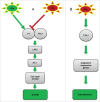Photoperiodic growth control in perennial trees
- PMID: 26340077
- PMCID: PMC4854358
- DOI: 10.1080/15592324.2015.1087631
Photoperiodic growth control in perennial trees
Abstract
Plants have to cope with changing seasons and adverse environmental conditions. Being sessile, plants have developed elaborate mechanisms for their survival that allow them to sense and adapt to the environment and reproduce successfully. A major adaptive trait for the survival of trees of temperate and boreal forests is the induction of growth cessation in anticipation of winters. In the last few years enormous progress has been made to elucidate the molecular mechanisms underlying SDs induced growth cessation in model perennial tree hybrid aspen (Populus tremula × P. tremuloides). In this review we discuss the molecular mechanism underlying photoperiodic control of growth cessation and adaptive responses.
Keywords: adaptation; growth cessation; hybrid aspen; perennial trees; photoperiod.
Figures
Similar articles
-
Photoperiodic control of seasonal growth is mediated by ABA acting on cell-cell communication.Science. 2018 Apr 13;360(6385):212-215. doi: 10.1126/science.aan8576. Epub 2018 Mar 8. Science. 2018. PMID: 29519919
-
Photoperiod- and temperature-mediated control of growth cessation and dormancy in trees: a molecular perspective.Ann Bot. 2017 Sep 1;120(3):351-360. doi: 10.1093/aob/mcx061. Ann Bot. 2017. PMID: 28605491 Free PMC article. Review.
-
Branching Regulator BRC1 Mediates Photoperiodic Control of Seasonal Growth in Hybrid Aspen.Curr Biol. 2020 Jan 6;30(1):122-126.e2. doi: 10.1016/j.cub.2019.11.001. Epub 2019 Dec 12. Curr Biol. 2020. PMID: 31839452
-
Storage lipid accumulation is controlled by photoperiodic signal acting via regulators of growth cessation and dormancy in hybrid aspen.New Phytol. 2018 Jul;219(2):619-630. doi: 10.1111/nph.15197. Epub 2018 May 15. New Phytol. 2018. PMID: 29761498
-
Daylength mediated control of seasonal growth patterns in perennial trees.Curr Opin Plant Biol. 2013 Jun;16(3):301-6. doi: 10.1016/j.pbi.2013.02.006. Epub 2013 Mar 7. Curr Opin Plant Biol. 2013. PMID: 23473967 Review.
Cited by
-
A metabolic daylength measurement system mediates winter photoperiodism in plants.Dev Cell. 2021 Sep 13;56(17):2501-2515.e5. doi: 10.1016/j.devcel.2021.07.016. Epub 2021 Aug 17. Dev Cell. 2021. PMID: 34407427 Free PMC article.
-
EARLY BUD-BREAK 1 and EARLY BUD-BREAK 3 control resumption of poplar growth after winter dormancy.Nat Commun. 2021 Feb 18;12(1):1123. doi: 10.1038/s41467-021-21449-0. Nat Commun. 2021. PMID: 33602938 Free PMC article.
References
-
- Samish RM. Dormancy in woody plants. Ann Rev Plant Physiol 1954; 5:183-204; http://dx.doi.org/10.1146/annurev.pp.05.060154.001151 - DOI
-
- Junttila O. Effect of photoperiod and temperature on apical growth cessation in two ecotypes of Salix and Betula. Physiologia Plantarum 1980; 48:347-52; http://dx.doi.org/10.1111/j.1399-3054.1980.tb03266.x - DOI
-
- Heide OM, Prestrud AK. Low temperature, but not photoperiod, controls growth cessation and dormancy induction and release in apple and pear. Tree Physiol 2005; 25:109-14; PMID:15519992; http://dx.doi.org/10.1093/treephys/25.1.109 - DOI - PubMed
-
- Rohde A, Prinsen E, De Rycke R, Engler G, Van Montagu M, Boerjan W. PtABI3 impinges on the growth and differentiation of embryonic leaves during bud set in poplar. Plant Cell 2002; 14:1885-901; PMID:12172029; http://dx.doi.org/10.1105/tpc.003186 - DOI - PMC - PubMed
-
- Böhlenius H, Huang T, Charbonnel-Campaa L, Brunner AM, Jansson S, Strauss SH, Nilsson O. CO/FT Regulatory Module Controls Timing of Flowering and Seasonal Growth Cessation in Trees. Science (New York, NY) 2006; 312:1040-3; http://dx.doi.org/10.1126/science.1126038 - DOI - PubMed
Publication types
MeSH terms
LinkOut - more resources
Full Text Sources
Other Literature Sources

